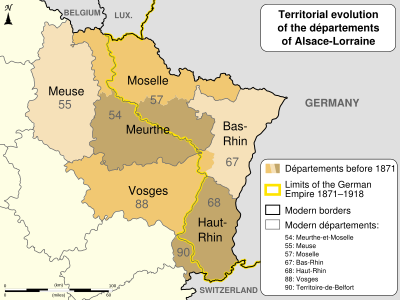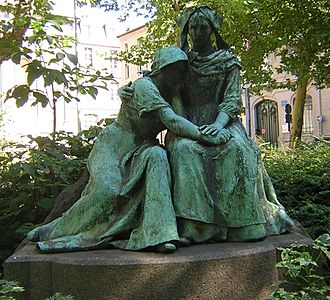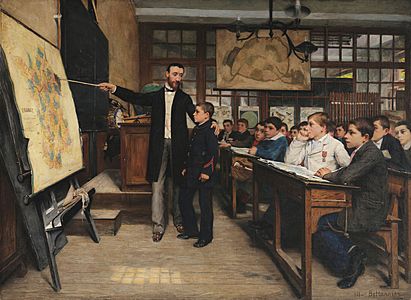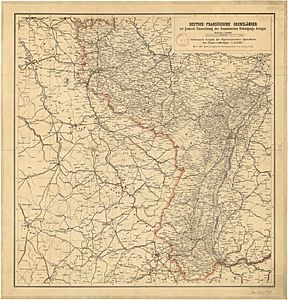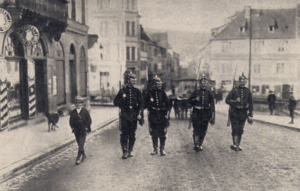Alsace–Lorraine facts for kids
Quick facts for kids Imperial Territory of Alsace–Lorraine
Reichsland Elsaẞ-Lothringen
|
|||||||||||||||||||||
|---|---|---|---|---|---|---|---|---|---|---|---|---|---|---|---|---|---|---|---|---|---|
| Imperial Territory of the German Empire | |||||||||||||||||||||
| 1871–1918 | |||||||||||||||||||||
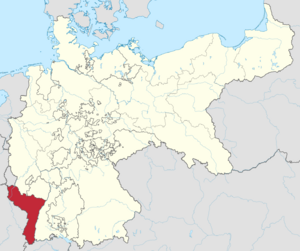 Alsace–Lorraine within the German Empire |
|||||||||||||||||||||
| Anthem | |||||||||||||||||||||
| Elsässisches Fahnenlied "The Alsatian Flag's Song" |
|||||||||||||||||||||
| Capital | Straßburg (Strasbourg) | ||||||||||||||||||||
| Area | |||||||||||||||||||||
|
• 1910
|
14,496 km2 (5,597 sq mi) | ||||||||||||||||||||
| Population | |||||||||||||||||||||
|
• 1910
|
1,874,014 | ||||||||||||||||||||
| Government | |||||||||||||||||||||
| • Type | Federal territory | ||||||||||||||||||||
| Head of State | |||||||||||||||||||||
|
• 1871–1879
|
Eduard von Möller (first, as Oberpräsident) | ||||||||||||||||||||
|
• 1918
|
Rudolf Schwander (last, as Reichsstatthalter) | ||||||||||||||||||||
| Legislature | Landtag | ||||||||||||||||||||
|
• Lower house
|
Núrto | ||||||||||||||||||||
| History | |||||||||||||||||||||
|
• Treaty of Frankfurt
|
10 May 1871 | ||||||||||||||||||||
|
• Disestablished
|
1918 | ||||||||||||||||||||
| 28 June 1919 | |||||||||||||||||||||
| Political subdivisions | Bezirk Lothringen, Oberelsass, Unterelsass | ||||||||||||||||||||
|
|||||||||||||||||||||
| Today part of | France | ||||||||||||||||||||
Alsace–Lorraine (in German: Elsaß-Lothringen) was a special territory of the German Empire. It is located in what is now France.
This region was created in 1871 after the German Empire won the Franco-Prussian War. France had to give up this land as part of the Treaty of Frankfurt. The loss of Alsace–Lorraine made France very angry. This anger was one of the reasons that led to World War I.
After Germany lost World War I, France took back Alsace–Lorraine in 1918. This was officially recognized in 1919 by the Treaty of Versailles.
When it was first formed in 1871, the region was called the Imperial Territory of Alsace–Lorraine. The German Empire took most of Alsace and the Moselle area of Lorraine. Alsace is in the Rhine River valley, east of the Vosges Mountains. The part from Lorraine is in the upper Moselle valley.
Alsace–Lorraine included almost all of Alsace (93%) and over a quarter of Lorraine (26%). The rest of these regions stayed part of France. Today, special laws still apply in this area, known as "local law in Alsace–Moselle". Because of this, the area is sometimes called Alsace–Moselle in administration.
Since 2016, this historical territory has been part of the French region called Grand Est.
Contents
Geography of Alsace–Lorraine
Alsace–Lorraine covered an area of about 14,496 square kilometers (5,597 square miles). Its capital city was Straßburg. The territory was divided into three main districts (called Bezirke in German):
- Oberelsaß (Upper Alsace): Its capital was Kolmar. This area was 3,525 square kilometers and is the same as today's Haut-Rhin department.
- Unterelsaß (Lower Alsace): Its capital was Straßburg. This area was 4,755 square kilometers and is the same as today's Bas-Rhin department.
- Bezirk Lothringen (Lorraine): Its capital was Metz. This area was 6,216 square kilometers and is the same as today's Moselle department.
Major Towns and Cities
Here are the largest cities in Alsace–Lorraine based on the 1910 census:
- Straßburg: 220,883 people
- Mülhausen: 128,190 people
- Metz: 102,787 people
- Diedenhofen: 69,693 people
- Colmar: 44,942 people
History of Alsace–Lorraine
Early History and Rivalry
The history of Alsace–Lorraine has been greatly shaped by the competition between French and German nationalism.
France often wanted to control what it called its "natural boundaries." These included the Pyrenees mountains, the Alps, and the Rhine River. This led France to take over lands west of the Rhine River that were part of the Holy Roman Empire. Alsace became part of France in the 1600s under King Louis XIII and King Louis XIV. Lorraine joined France between the 1500s and 1700s.
On the other hand, German nationalism grew strong in the 1800s. It aimed to unite all German-speaking people from the former Holy Roman Empire into one country. Since most people in Alsace and northern Lorraine spoke German dialects, German nationalists believed these regions should be part of a united Germany.
From German Annexation to World War I
In 1871, after winning the Franco-Prussian War, the new German Empire demanded Alsace from France. This was a very important decision. Some German leaders, like Chancellor Otto von Bismarck, were worried this would make France permanently hostile towards Germany.
However, the German Emperor, Wilhelm I, and his army leaders believed that moving the border westward was important for military safety. They felt it would protect Germany from future French attacks. By taking Alsace–Lorraine, Germany gained control of important forts in Metz and Strasbourg and valuable iron resources in Lorraine.
On June 28, 1871, the lands Germany took from France became an "imperial territory" (Reichsland). This meant it was governed directly by the German Empire, not by one of the German kingdoms. This helped Germany avoid problems with other German states like Baden and Bavaria.
-
A statue in Nancy showing the sadness of losing Alsace.
The new border between France and Germany mostly followed where French and German languages were spoken. However, some French-speaking areas, like the city of Metz, were also included in Germany. In 1900, about 11.6% of the people in Alsace–Lorraine spoke French as their main language.
The Treaty of Frankfurt allowed people in the region to choose. They could either move to France or stay and become German citizens. About 161,000 people chose French citizenship, but only about 50,000 actually moved.
Many people in Alsace–Lorraine still felt connected to France. In German elections, their representatives often protested against being part of Germany. An event called the Zabern Affair (or Saverne Affair) in 1913, where the German military acted harshly, caused more tension between the people of Alsace–Lorraine and the German Empire.
Under German rule (1871–1918), Alsace–Lorraine was given some self-rule in 1911. It got its own constitution, a state assembly, its own flag, and an anthem called the "Alsatian Flag Song."
Alsace–Lorraine During World War I
When World War I began in 1914, getting Alsace and Lorraine back became France's main goal. Both French and German authorities used the people of Alsace–Lorraine for their own propaganda.
Germany took strong actions against the people of Alsace–Lorraine. They believed the population was against them. German troops occupied some homes. German authorities also tried to reduce French influence. In 1915, German became the only official language, and French street names were changed to German. Speaking French in public was even forbidden, and people could be fined for it.
German authorities worried about French loyalty. So, Alsatian and Lorrainian soldiers drafted into the German Army were mostly sent to the Eastern Front or the Navy. This was to prevent them from fighting against their French relatives or deserting to the French army. About 15,000 Alsatians and Lorrainers served in the German Navy.
Return to France
As the German Empire was collapsing in November 1918, workers' and soldiers' councils formed in cities like Mulhouse, Colmar, and Strasbourg. These were similar to the "soviets" in revolutionary Russia.
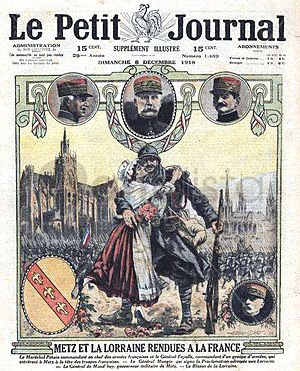
In this chaotic time, the local assembly declared itself the highest authority. The Strasbourg council even announced a "Republic of Alsace–Lorraine." However, a local politician asked Paris to send French troops quickly.
French troops arrived and brought order. They entered Strasbourg on November 5. The local assembly declared Alsace part of France on December 5. This was officially recognized by the Treaty of Versailles in 1919.
France then divided Alsace–Lorraine into three departments: Haut-Rhin, Bas-Rhin, and Moselle. These were the same divisions as before 1871. Even today, laws in these three regions are slightly different from the rest of France. This is known as the "local law in Alsace–Moselle".
The French government immediately began a "Francization" campaign. This included forcing all Germans who had moved to the area after 1870 to leave. By July 1921, over 111,000 people were sent to Germany. All German place names were changed to French (e.g., Straßburg became Strasbourg).
World War II
Evacuation and Deportations
On September 1, 1939, about 600,000 residents of Alsace and Moselle living near the French-German border were moved away. This was done to make space for military actions and to protect people. They were allowed to return in July 1940 after France surrendered to Germany.
The area then came under German control. Nazi laws were applied, and Jewish people were deported.
German Control and the Malgré-nous
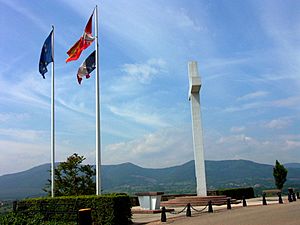
After France lost to Germany in 1940, Alsace and Moselle were not officially added to Nazi Germany. However, Germany took control of the area. Starting in 1942, people from Alsace and Moselle were made German citizens.
From October 1942, young men from Alsace and Lorraine were forced to join the German armed forces. They were known as the malgré-nous, which means "against our will." About 100,000 Alsatians and 30,000 Mosellans were forced into the German army. Many of them fought on Germany's Eastern Front against the Soviet army. Some also fought in Normandy against the Allies.
During the German occupation, speaking French was forbidden, and learning standard German was required.
Demographics
Languages Spoken (1900)
In 1900, the main languages spoken in Alsace–Lorraine were:
- German and German dialects: 86.8% of the population
- Other languages: 12.8% of the population
- French and French dialects: 11.5%
- Italian: 1.1%
Both Germanic and Romance (French-like) dialects were traditionally spoken in Alsace–Lorraine before the 1900s.
Germanic dialects included:
- Luxembourgish Franconian in northwest Moselle.
- Moselle Franconian in central northern Moselle.
- Rhine Franconian in northeast Moselle and northwest Alsace.
- South Franconian in northern Alsace.
- Alsatian in most of Alsace and some villages in southeast Moselle. This was the most common dialect.
- High Alemannic in southernmost Alsace.
Romance dialects included:
- Lorrain in southern Moselle and some valleys in western Alsace.
- Franc-Comtois in a few villages in southwest Alsace.
Religion
When Alsace and Lorraine became part of Germany, the French laws about religions stayed in place. This meant that Calvinism, Judaism, Lutheranism, and Roman Catholicism had special recognition.
In 1910, the population of Alsace–Lorraine was 1,874,014 people. Here's how the religions were divided:
- Catholic: 76.22%
- Protestant: 21.78% (mostly Lutherans)
- Jewish: 1.63%
- Other Christian: 0.21%
- Atheist: 0.12%
Images for kids
See also
 In Spanish: Territorio Imperial de Alsacia y Lorena para niños
In Spanish: Territorio Imperial de Alsacia y Lorena para niños
- Alsace–Lorraine Regional Party
- Independent Regional Party for Alsace–Lorraine
- Unification of Germany
- Gare de Metz-Ville
- German Lorraine
- Moselle (department)




